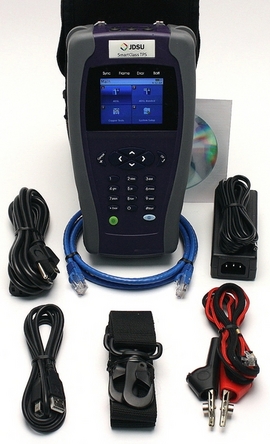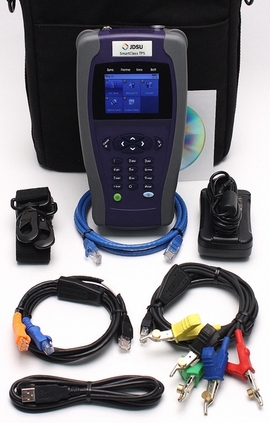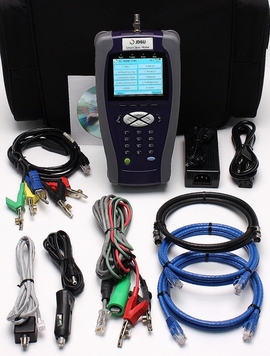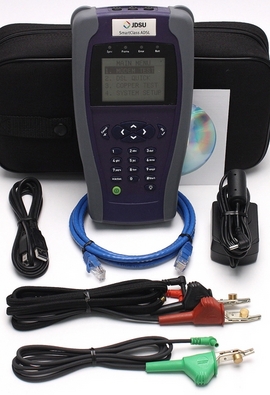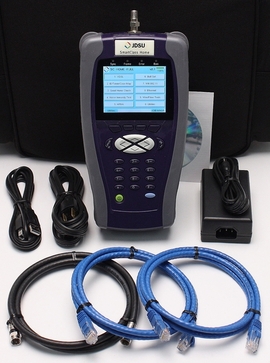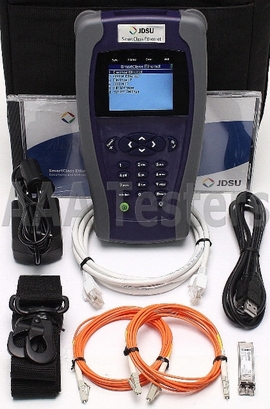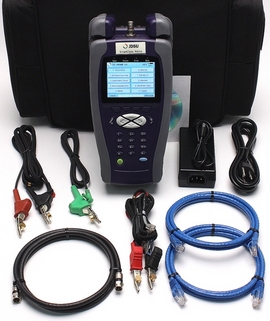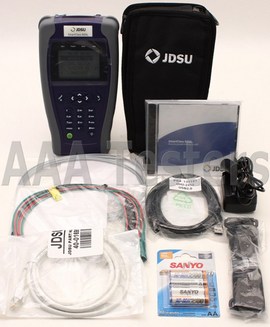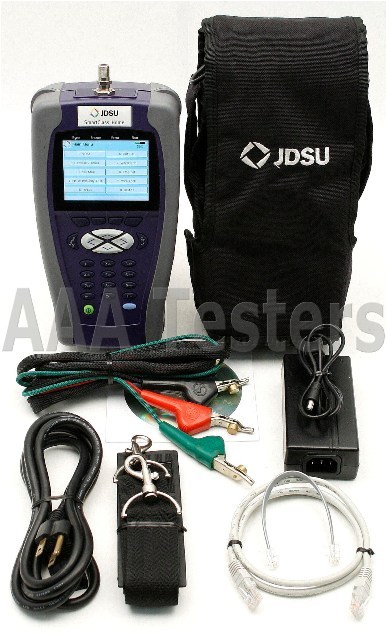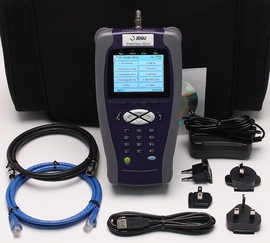
If you’re looking to Sell JDSU SC-HOME-HPNA V2.7 martClass Home Tester
JDSU SmartClass HPNA Tester
The SmartClass Home HPNA handheld service meter enables verification of HPNA networks as well as the internal wiring at the customer premises for proper operation of voice, video, and data services. The SmartClass Home is used to test HPNA inside the premise, as well as the coax and twisted pair wiring inside the subscriber’s location. The SmartClass Home provides an easy-to-use, accurate, and economical measurement tool for service technicians installing or troubleshooting triple-play services over existing or new networks.
The SmartClass Home includes a unique set of features to completely qualify the subscriber’s premises for triple-play services that use HPNA technology as well as the physical media to deliver communication signals throughout the site. The Coax Map feature and the Noise Immunity Test can be used to assess quality and troubleshooting issues in a coax network. The Active ID can delineate multiple runs of coax in the building even through coaxial splitters. The integrated wiring tools can also be used to qualify twisted pair, including Cat3, Cat5, Cat5e, and Cat6 cables. The SmartClass Home saves time and effort in verifying and troubleshooting inside wiring problems before the subscriber notices them.
The SmartClass Home also includes a unique feature set for testing Ethernet data networks in residential and small-to-medium-sized business (SMB) locations. The built-in 802.11b/g wireless feature ensures correct WiFi functionality in and around the subscriber locations. Additional features include a fully functional built-in butt-set, which can be used to test POTS voice delivery along with wiring identification and toning to locate and identify cables.
Combined with an easy-to-use menu structure, the features of the SmartClass Home represent the best all-in-one service and wiring tester available.
HPNA Network Testing
HPNA, a technology standard developed by the HomePNA™ Alliance, builds on Ethernet and allows all the components of a home network to connect and integrate over an unpredictable wiring topology. The HPNA communication is used to pass information around a home to other HPNA-connected devices.
In HPNA mode, the SmartClass Home connects to, and communicates with, other HPNA-capable devices, or nodes, operating in spectral mode B on the same network.
By establishing itself as a network node on a live HPNA network, the SmartClass Home can test each of the various nodes on the network. SmartClass Home allows users to segment problem node paths, node-to-node communication issues, or to verify that the whole network is running correctly. The SmartClass Home lets users verify that HPNA networks are operating within expected service quality metrics and set up PASS/FAIL limits to help simplify testing.
Coaxial Cable Testing
Coax is gaining popularity as the medium of choice for transferring communications in and around customer premises. Whether the technology is broadcast or IP video, data over coax technologies, or whole-home digital video recorder (DVR) services, the SmartClass Home can ensure that the inside coaxial plant is properly connected. The SmartClass Home also helps technicians detect and eliminate unwanted coaxial elements such as hidden splitters, bad barrels, and damaged cables
Coax Map
The Coax Map feature of the SmartClass Home is a single-ended coax physical layer test based on frequency domain reflectometry (FDR), a powerful technique used in analyzing RF transmission lines. The Coax Map test measures signal quality as it passes through the transmission line by identifying impairments that cause standing waves.
Coax Active Identification
The SmartClass Home helps technicians quickly identify which cable goes to which room in a house. Using the Cable ID mode, technicians can determine coax wire endings for each room with a coax run. A common problem occurs when an unexpected splitter exists in the middle of the coax run. However, the Active IDs of the SmartClass Home work through splitters to display multiple IDs, which helps to locate the wall outlet or outlets that are connected via a splitter network.
Noise Immunity Test
The Noise Immunity Test (NIT) provides good indications of coaxial cable shielding issues. Problems arise when the inside coax has staples, sheared jacketing, an exposed stinger, or an unterminated end present. The NIT gives technicians a better chance of catching impairments before subscribers experience service degradation. The NIT measures the signal strength of local FM carriers and compares them to the same measurement on the cable to determine the isolation of the coax to off-air ingress.
Twisted Pair Testing
The SmartClass Home provides a suite of twisted pair measurements to ensure the correct connections and wiring of POTS and Ethernet cables.
Twisted Pair Wire Mapping
The Twisted Pair Wire Map provides details about the cable length, distance to opens and shorts, skew, and the connection mapping of each wire when used with the SmartRemote. This information lets technicians quickly locate improper wire connections and the presence of physical layer issues. The SmartClass Home can map different types of twisted pair cables such as Cat5/5e/6 Ethernet and straight or Cat3 phone wiring.
Loop Length
The Loop Length test is an open capacitance test that calculates the length of the twisted pair cable. Intended more for lengthy twisted pair runs the Loop Length test lets technicians easily verify cable run lengths.
Butt-Set
The SmartClass Home has a built-in butt-set with speaker phone that helps technicians quickly verify voice communications and troubleshoot POTS issues. The results indicate voltage and current on the line as well as the number dialed and the status of the POTS line. Technicians can store a list of frequently called numbers for easy dialing. The butt-set provides call waiting and displays the caller ID for incoming calls. The speaker phone lets technicians listen for dial tone or voice and talk during calls without a separate headset.
Ethernet
The SmartClass Home includes a suite of Ethernet connectivity tests to help users quickly identify connectivity issues on customer premises equipment connected to the network.
Port Discovery
The Port discovery test displays the established link rate on the Ethernet connection between the SmartClass Home and a router. It also displays the available rates and the signal-to-noise ratios (SNRs) of each active twisted pair. This information helps technicians pinpoint connection issues between the customer premises equipment (CPE) devices and the premises router.
Ping
Ping tests let technicians verify network connectivity to a particular Internet Protocol (IP) or Universal Resource Locator (URL) address. They can also verify that a particular location is capable of reaching either the Internet or a specific server on the network, which lets technicians avoid using customer equipment or a laptop to perform simple connectivity tests.
Hub Flash
The Hub Flash test is an additional Ethernet test available on the SmartClass Home intended for locations with multiple Ethernet connections running to a central device. The Hub Flash will cause the port light to flash on the hub/switch/router indicating that the SmartClass is connected. This simple identification method lets technicians quickly determine which port is connected to a particular run.
Wireless 802.11b/g
The SmartClass Home provides optional WiFi wireless 802.11b/g testing capabilities to show the secure set identification (SSID), configured channel, 802.11 modulation, mode, and signal strength at the test location of each wireless 802.11b/g network in the area. It also indicates whether the network is secure or vulnerable to security threats. This capability lets technicians properly set up the subscriber’s network and troubleshoot wireless connectivity or issues with websurfing speed.
Volt/Ohm Measurement
The SmartClass Home will indicate the presence of voltages on a line prior to connecting sensitive CPE devices. Measurements can be performed on either coax or twisted pair and indicates the presence of AC or DC voltages. The SmartClass Home also has a quick ohm measurement test that can be used to verify opens, shorts, or resistances between 100 ? and 400 k?, which eliminates the need for technicians to carry separate tools to perform quick voltage or resistance checks.
File Manager
Users can save the results for almost all tests for archival and future review. The unit saves the results in the common .csv format which can be opened using various spreadsheet and other applications. The files are exported via a common universal storage bus (USB) flash storage device. The SmartClass Home can hold thousands of result files that can be removed, renamed, and exported from the unit easily using the built-in File Manager application.
Applications:
- Validate and troubleshoot live HPNA networks
- Verify residential, MDU, and SMB internal wiring
- Eliminate carrying multiple wiring and internal network test devices
- Perform accurate tests to lcate and troubleshoot disruptions for internal network data, voice and video service
- Verify Ethernet, POTS, and 802.11b/g wireless functionality to ensure trouble-free services
Key Features:
- Easy-to-use, accurate, and economical handheld test instrument.
- HPNA V3.1 Coax or Twisted Pair Node Testing
- Coax Mapping with splitter identification and location
- Noise Immunity Test measures coax shield isolation
- Coax cable identification through splitters and other coax network elements
- Physical layer testing for coax, Cat3/Cat5/Cat5e/Cat6 Cables
- Ethernet testing, including port identification and ping
- POTS butt set with diagnostics and loudspeaker
- 802.11b/g wireless signal testing
- 320×240 high brightness color graphical LCD
Buying, Selling, Trading JDSU SC-HOME-HPNA V2.7
Specifications:
If you’re selling your JDSU SC-HOME-HPNA V2.7 please fill out form on the right hand side of page.

